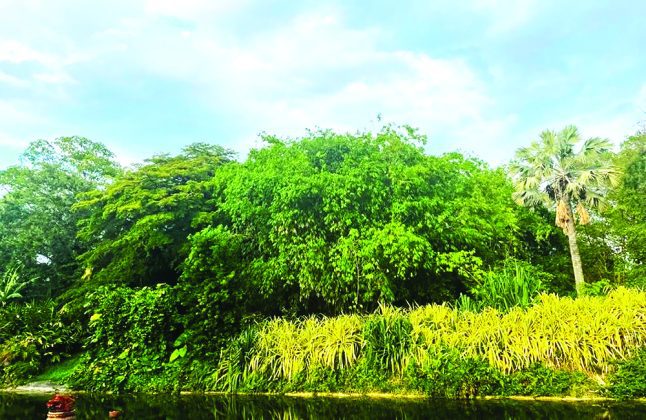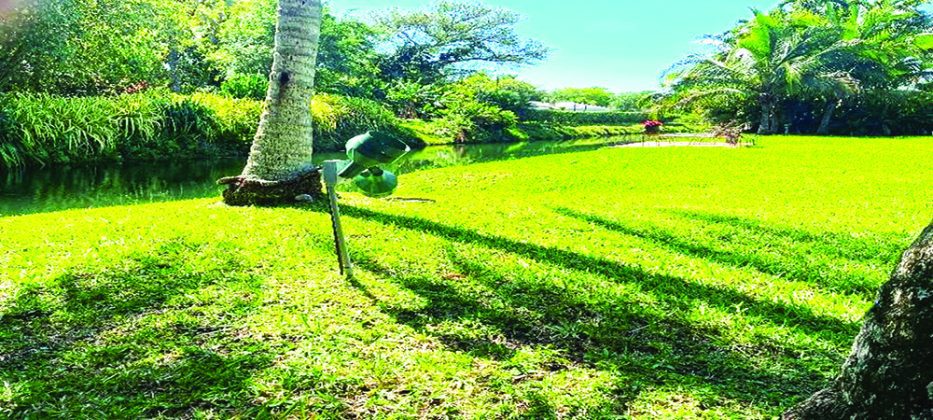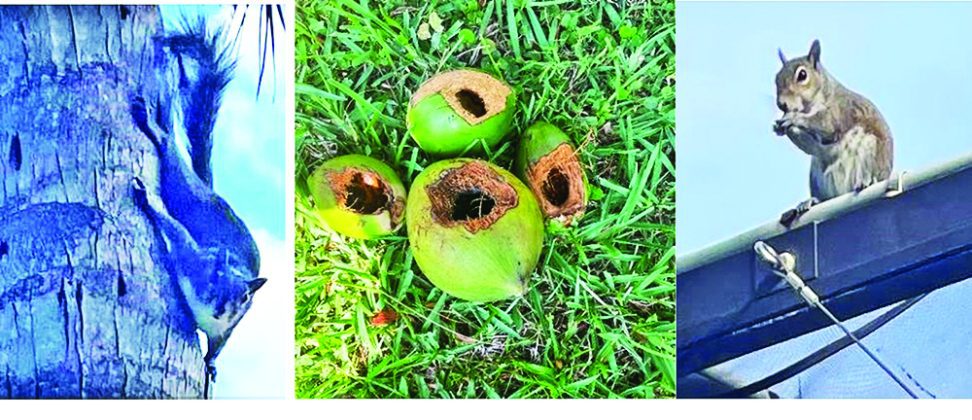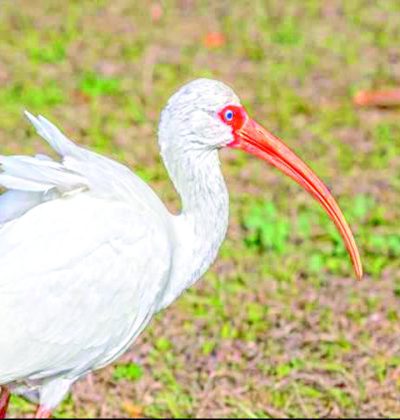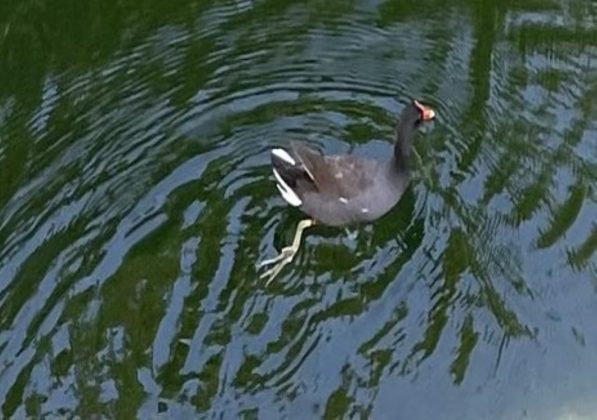|
Getting your Trinity Audio player ready...
|
Panoramic views from across our waterway and backyard. In a neighborhood of primarily brick and mortar, it’s especially noticeable that our backyard landscape is a tropical forest, thanks to our across the canal neighbor. From time to time, I ask them if they are moving and so far, the answer has been no. Otherwise, up pops the dreaded sugar cube home.
Sandy and I always enjoyed living near water. Particularly myself because of my love of fishing. From 1970 through 1972, we lived along a saltwater canal in Bradenton, Florida while I was a sportswriter for the Bradenton Herald.
Our dream came true when we bought a home bordering a freshwater canal in 1993, located at 13221 Southwest 69th Court in Pinecrest Florida.
Even before we began unloading furniture and other personal and household items, I was enjoying our new backyard view along the canal bank. Then the critters began appearing – ducks, ibis, squirrels, purple gallinules, and schools of fish. Paradise found!
OUR INCREDIBLE SQUIRRELS
My first animal encounter was with a family of grey squirrels. These eight-ounce rodents provide an important ecological benefit in the spread of seeds that grow into grasses, trees, shrubs and flowers. I thoroughly enjoy watching them, particularly when gnawing through coconuts for milk and pulp. Lessons learned: If they can master the impenetrable coconut, imagine the damage to a human. So, when I feed them peanuts, I keep a reasonable distance just in case. Of all the critters that reside in my backyard, there is nothing more entertaining than enjoying a squirrel perched upright while eating a peanut.
OUR FEATHERED FRIENDS
After all these years, I still haven’t resolved my feelings about these gosh darn Muscovy ducks. After all, I am a devout animal lover no matter how out of hand the bird population may increase. Not that I would ever do anything egregious to them. That said, I have learned over the years not to feed them infinite quantities of bread; bread to birds is like caviar to humans. My early mistakes triggered a population explosion that got well out of hand, so much so that I named them “pooping birds” versus Muscovy ducks for obvious reasons. In short, watch your step when walking around in the backyard.
When we moved here in 1993, the duck population was comprised of the domestic variety.
This species was law-abiding, unlike the Muscovy variety.
The largest flock would total around five versus Muscovys averaging ten or more, depending on how much bread they were fed.
Just for the record, Muscovy ducks are invasive, having migrated most likely due to human trafficking from South America as a food source for restaurants and the family table. It didn’t’ take a rocket scientist to solve my duck population explosion. Stop feeding copious quantities of bread to Muscovys.
Nowadays when I feed them, which is rare, they must share only a slice to prevent a population implosion. They also possess an unpleasant hissing sound versus the traditional quaking variety.
Unlike the unpleasant Muscovy’s, the elegant and peaceful herons are always welcome. The most frequenting my backyard are the White Ibis and the Blue Heron. Sometimes It’s a long wait but worth it, enjoying these graceful creatures hunting for fish, lizards and frogs along the shoreline.
Topping off my backyard aviary is the Purple Gallinule, a colorful chicken-sized member of the rail family.
An extremely cautious bird, it keeps its distance from us humans while feeding on flora and fauna along the shoreline.
This smallish bird has a noticeable tempo to its stride, imitating an almost soldier-like strut in its cadence.
Even from afar, they attempt to join in with the larger more aggressive ducks to get their fair share of bread. Only problem is having to toss bread balls beyond the hungry ducks to reach this very skittish little bird.
THE ORANGE GANG
Originally freshwater aquarium pets, the Orange Cichlid easily adapted to South Florida lakes and canals when abandoned by their owners. Being a subtropical species migrating from India, these quite stunning fish thrived in South Florida lakes and canals until severe winter weather almost wiped them out.
Several years ago, South Florida experienced an unusual winter with temperatures plummeting into the mid-thirties, promptly killing them off. Our backyard canal suddenly became a smelly graveyard with dead fish floating along the canal bank. I noticed that turkey vultures could not reach the decaying fish so, ingeniously, I netted and spread them along the bank. Soon the dead fish simply vanished, eaten by these scavengers. All it took were a few Cichlid survivors and in a short time, they were back at my feeding station begging for food. Admittedly, I have spoiled them over the years with either watered down bran flakes or oatmeal.
How many times have I shooed away fishermen trying to catch my fishy pets? They must think I need a shrink when I ask the anglers to please leave them alone. If necessary, I fib to them that this is a state wildlife sanctuary which works every time. Only once did a boater laugh aloud. I suddenly realized that a confrontation could happen and simply walked away. A fish or two may periodically get caught but replacements are always nearby. In fact, when there were fish population explosions, I encourage fishermen to keep a few.
THE SOLITARY IGUANA
Another backyard critter is the green iguana, an invasive reptile from South America that most likely also escaped from its owner’s cage. Fortunately, this large green lizard is harmless so long as it is left alone. In fact, you cannot get within a few yards of this swift reptilian before it scampers into the canal or up a tree. Also, like the movie, “Godzilla,” the resemblance is striking.
My only serious encounter with an iguana was years ago when a lizard somehow penetrated my pool patio enclosure. Armed with a large bath towel, I began chasing this quick and agile creature, finally cornering it next to a corner of the patio. Completely wrapped in my towel, I quickly sprinted to the screen door to release the Iguana, but it was much stronger than I anticipated and quickly wiggled itself from the towel. With Houdini like reflexes, it swung its head 360 degrees around the towel, sinking its teeth into my forearm. I immediately fell to the ground and the lizard forthwith let go. Nowadays, just seeing an iguana reminds me of the encounter and I simply walk away.
It’s rare to see these reptilians in pairs, always choosing to be solitary.
TROPICAL TREES ABOUND ON OUR PROPERTY
POOL PATIO
What better way to appreciate our backyard than from the vantage point of a gorgeous pool patio.
ABOUT US:
For more Miami community news, look no further than Miami Community Newspapers. This Miami online group of newspapers covers a variety of topics about the local community and beyond. Miami’s Community Newspapers offers daily news, online resources, podcasts and other multimedia content to keep readers informed. With topics ranging from local news to community events, Miami’s Community Newspapers is the ideal source for staying up to date with the latest news and happenings in the area.
This family-owned media company publishes more than a dozen neighborhood publications, magazines, special sections on their websites, newsletters, as well as distributing them in print throughout Miami Dade County from Aventura, Sunny Isles Beach, Miami Beach, Coral Gables, Brickell, Coconut Grove, Pinecrest, South Miami, Kendall, Palmetto Bay, Cutler Bay and Homestead. Each online publication and print editions provide comprehensive coverage of local news, events, business updates, lifestyle features, and local initiatives within its respective community.
Additionally, the newspaper has exclusive Miami community podcasts, providing listeners with an in-depth look into Miami’s culture. Whether you’re looking for local Miami news, or podcasts, Miami’s Community Newspapers has you covered. For more information, be sure to check out: https://communitynewspapers.com.
If you have any questions, feel free to email Michael@communitynewspapers.com or Grant@communitynewspapers.com.


